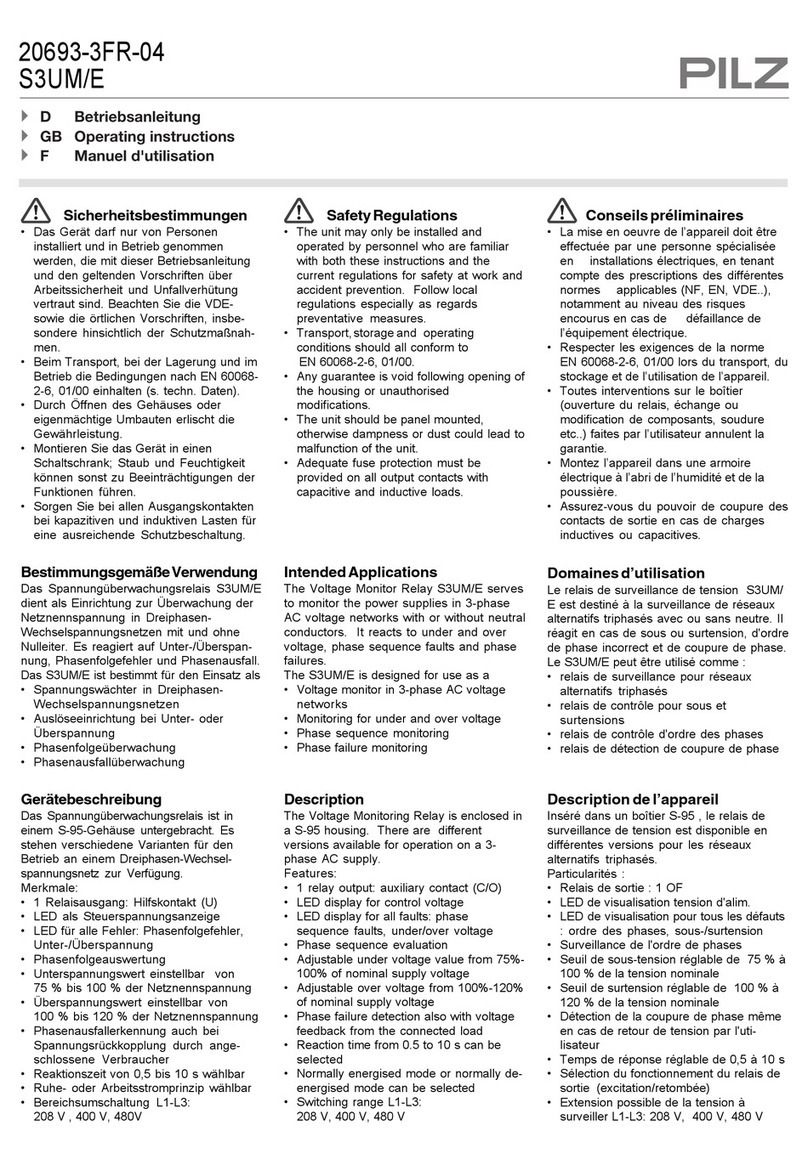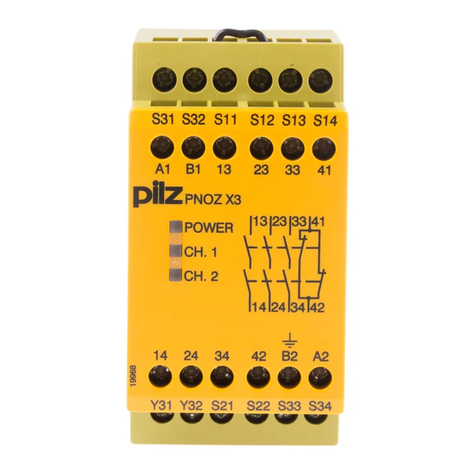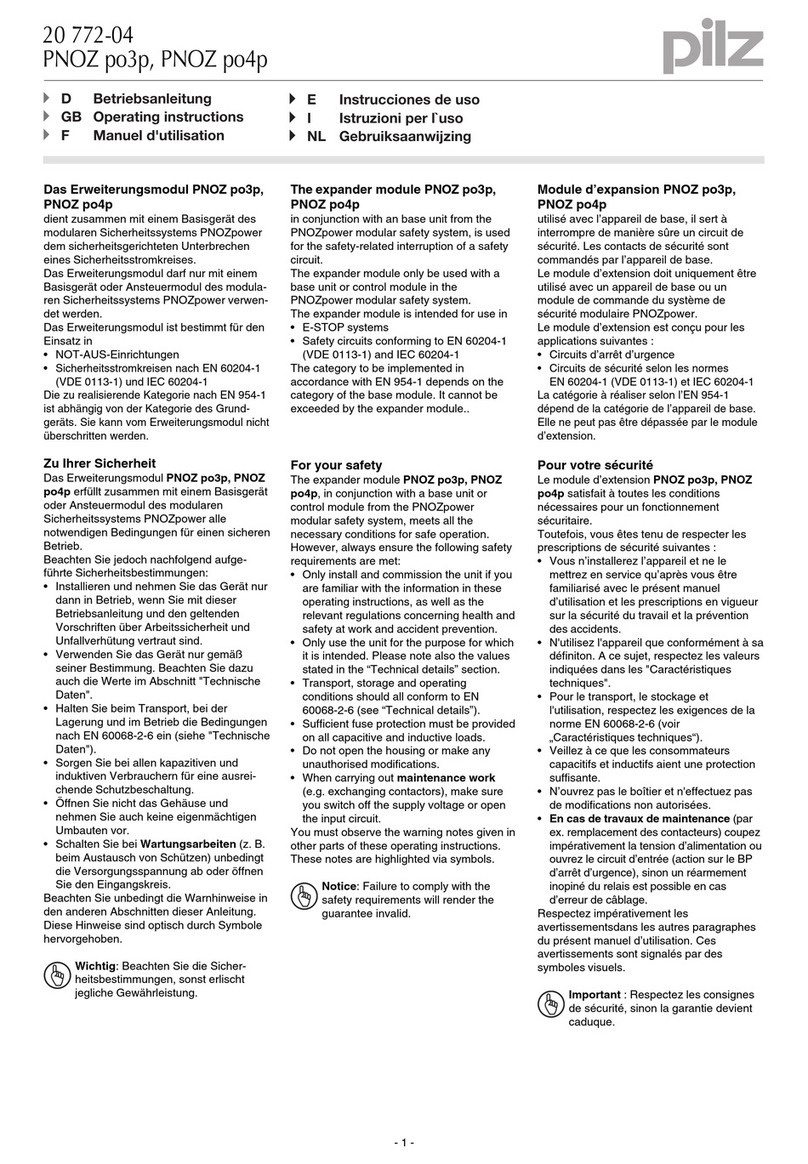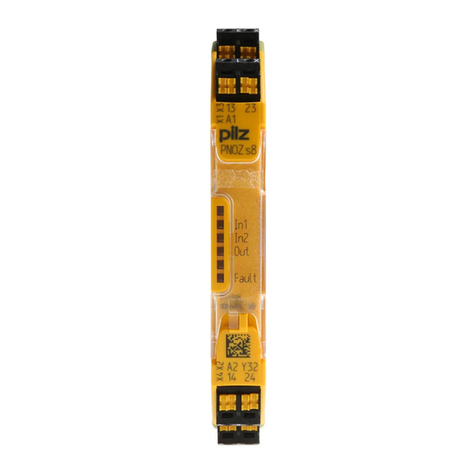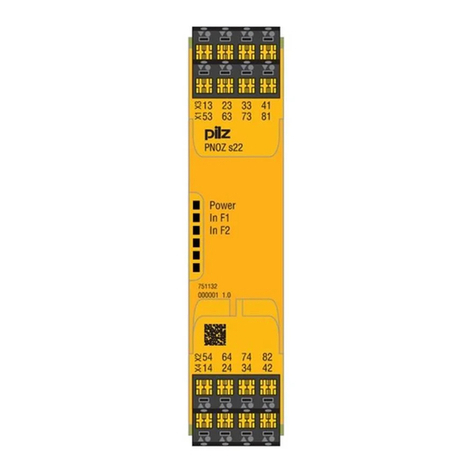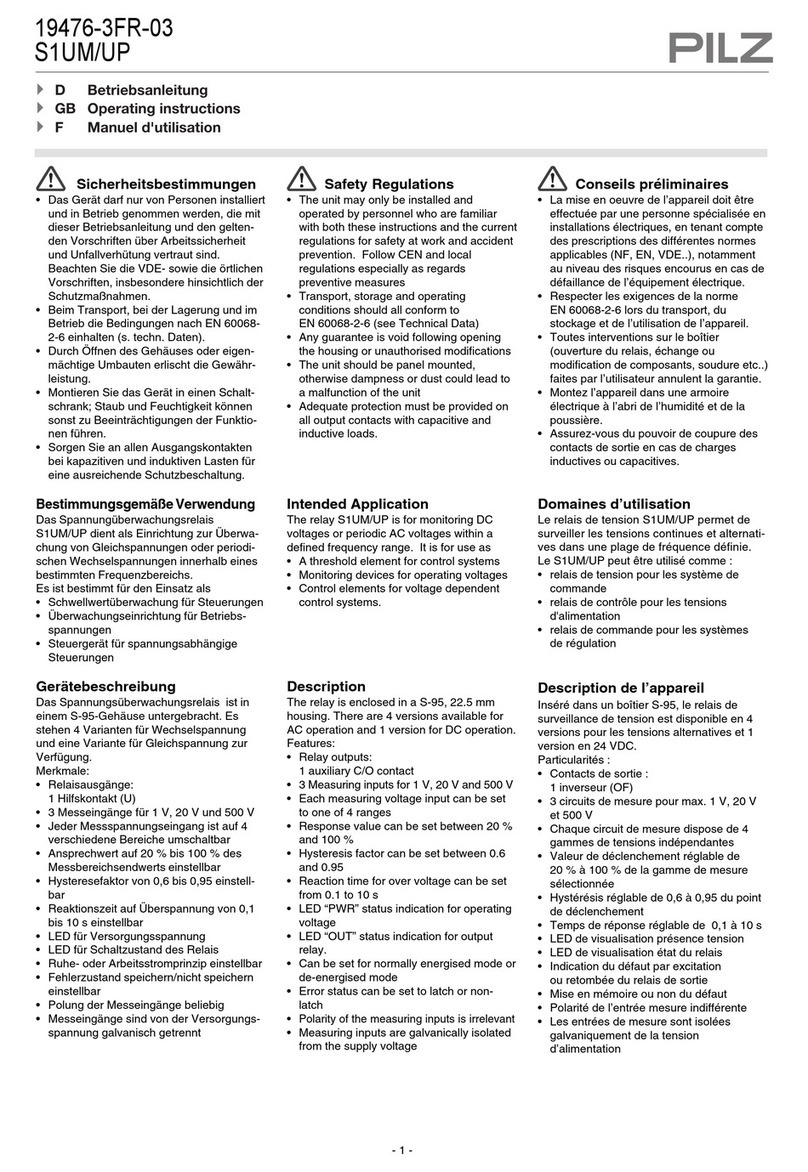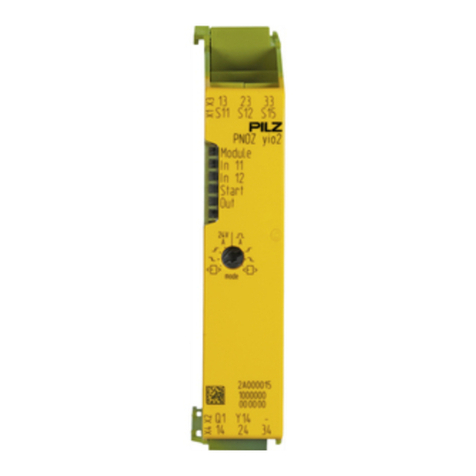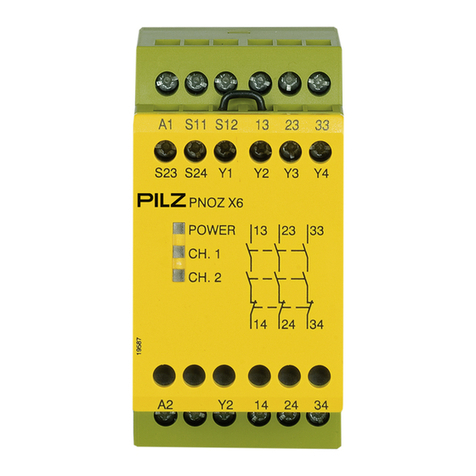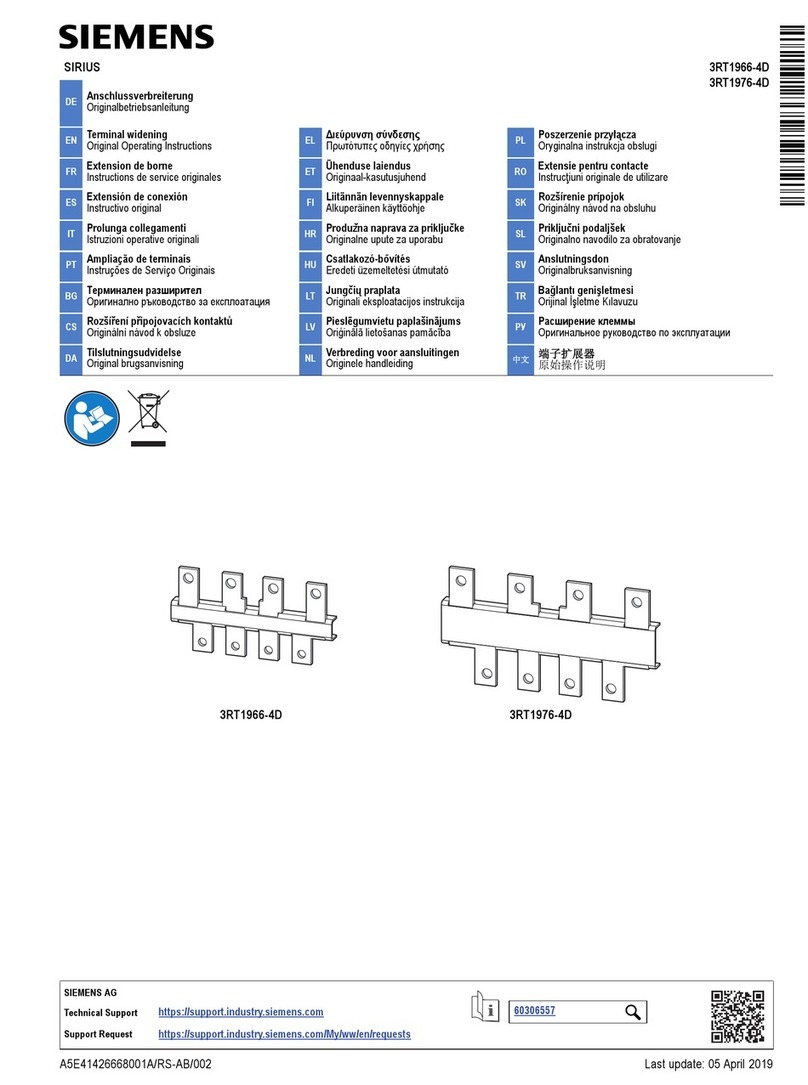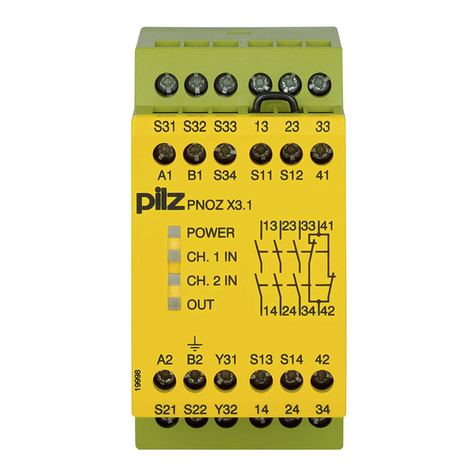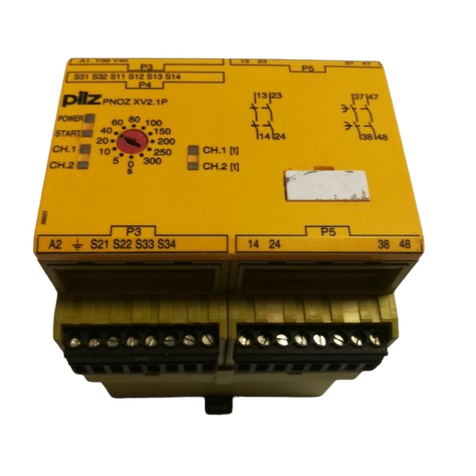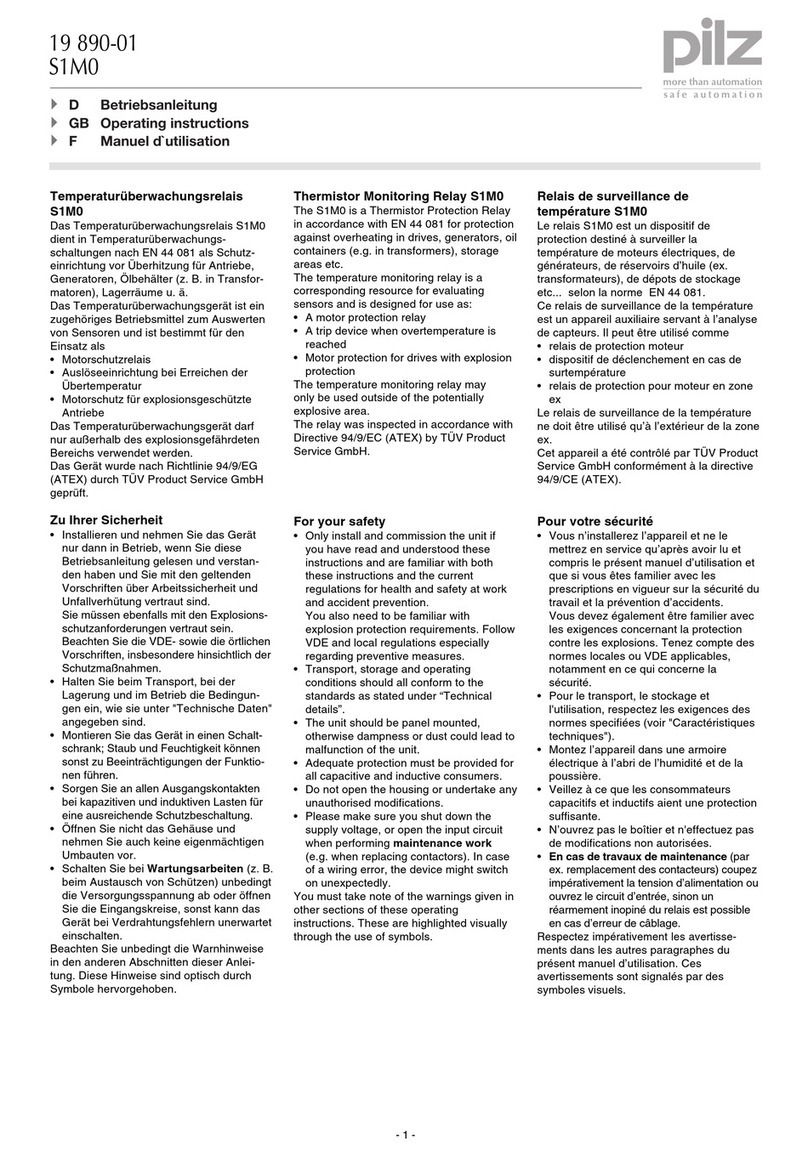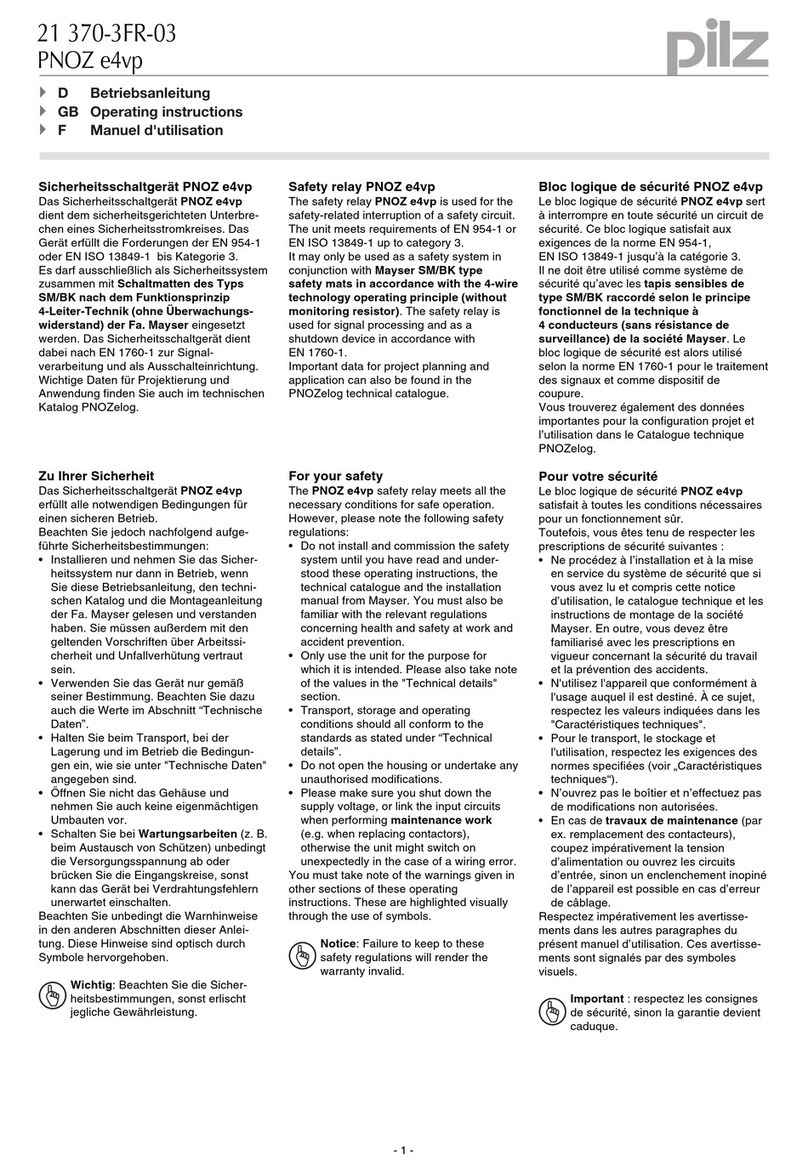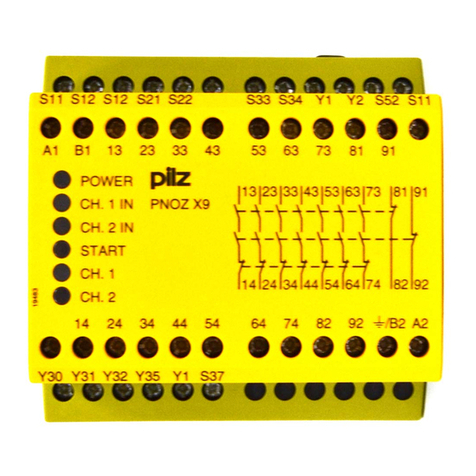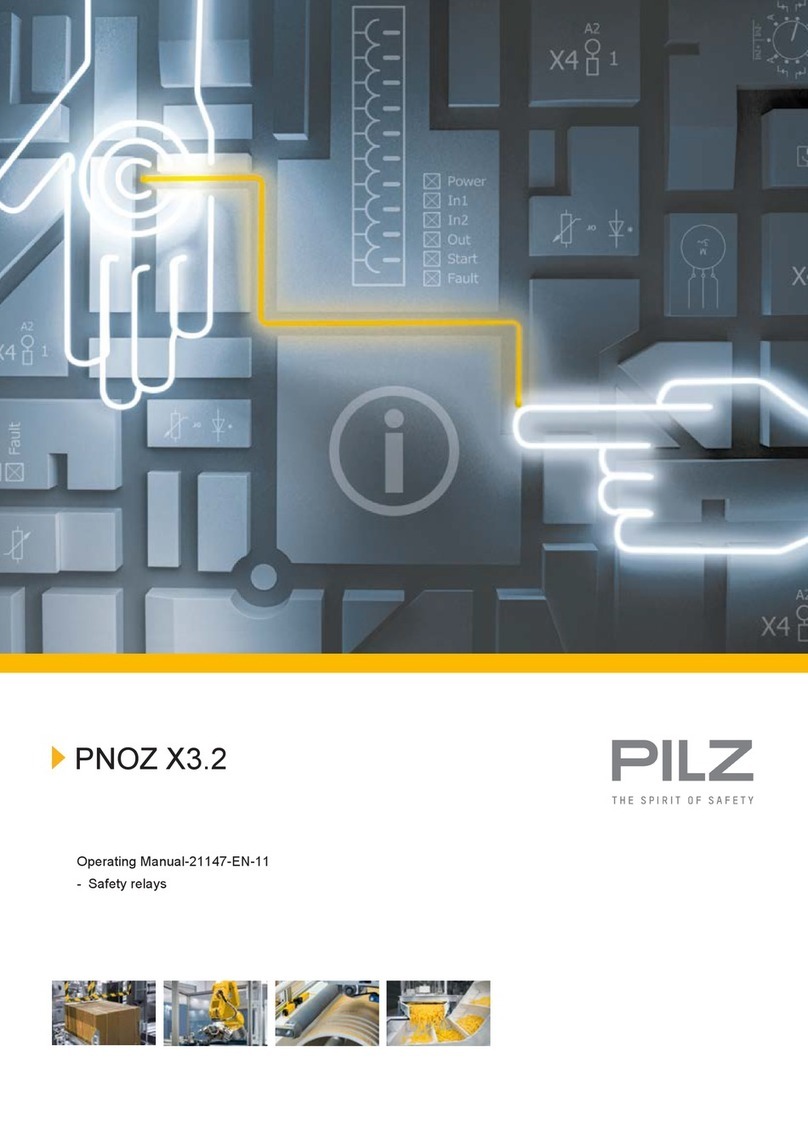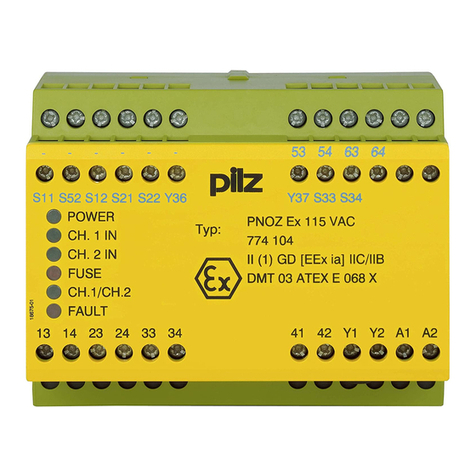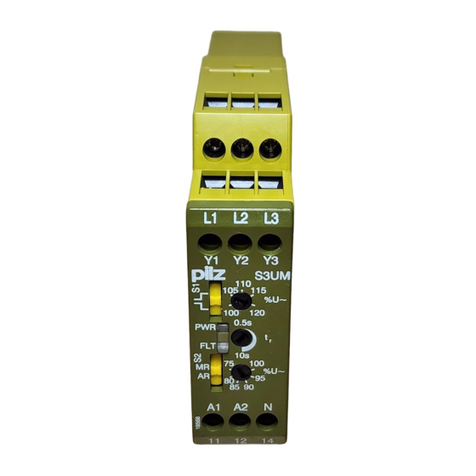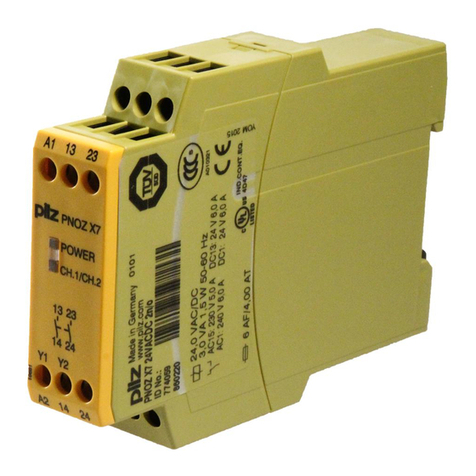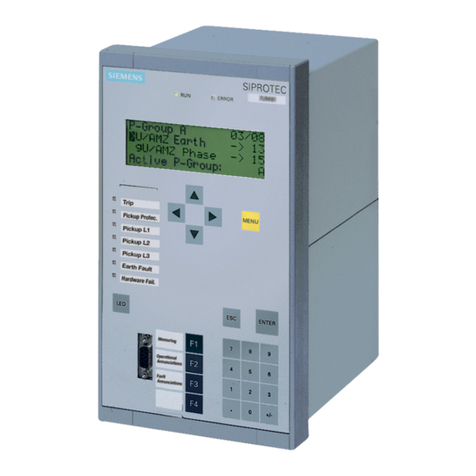
- 10 -
Descrizione del funzionamento
Il dispositivo elettrico PNOZ X2.3P serve
per interrompere in modo sicuro un circuito
elettrico di sicurezza. Dopo l’applicazione
della tensione di alimentazione si accende il
LED «POWER». Il dispositivo è pronto per il
funzionamento quando il circuito di start
S33-S34 è chiuso.
• Circuito di ingresso chiuso (per es.
pulsante di arresto di emergenza non
azionato):
i relè K1 e K2 si attivano automantenen-
dosi. Le visualizzazioni di stato
«
CH1
»
e
«
CH2
»
sono accese. I contatti di sicurezza
13-14/23-24/33-34 sono chiusi.
• Apertura del circuito di ingresso (per es. in
caso di azionamento del pulsante di
arresto di emergenza):
i relè K1 e K2 tornano nella posizione di
riposo. Le visualizzazioni di stato per
«CH1» e «CH2» si spengono. I contatti di
sicurezza 13-14/23-24/33-34 vengono
aperti in modo ridondante.
A1 (L+) A2 (L-)
S22
S12
S21
S11
S33 13
14
K1
K2
23
24
S34
Start
Unit
Start
Unit
Auto
Start
Y36 Y37
33
34
Fig. 1: Esquema de conexiones eléctricas/Schema
di collegamento interno/Intern schema
Modalità operative:
• Funzionamento monocanale: cablaggio di
ingresso secondo VDE 0113 parte 1 e EN
60204-1; senza ridondanza nel circuito di
ingresso, le dispersioni verso terra nel
circuito di start vengono rilevate. In caso
di dispersioni verso terra nel circuito di
arresto di emergenza scatta il fusibile
della tensione di alimentazione.
• Funzionamento bicanale: circuito di
ingresso ridondante; vengono rilevate le
dispersioni verso terra nel circuito del
pulsante, nonché il corto circuito tras-
versale tra i contatti del pulsante stesso.
• Start automatico: il dispositivo è attivo non
appena il circuito di ingresso è chiuso.
• Start manuale: L’apparecchio è attivo solo
dopo che è stato azionato un pulsante
start.
• Start controllato: il dispositivo è attivo
soltanto se prima di chiudere il circuito di
ingresso viene aperto il circuito di start e
se il circuito di start viene chiuso almeno
210 ms dopo la chiusura del circuito di
ingresso.
• Aumento del numero e della portata dei
contatti mediante il collegamento di relè
esterni.
Montaggio
Il dispsoitivo di sicurezza deve essere
montato in un armadio elettrico con un
grado di protezione di min. IP 54. Per il
fissaggio su una guida DIN è previsto un
elemento di blocco sul lato posteriore del
dispositivo.
Per il montaggio del dispositivo su una guida
DIN (35 mm) usando un elemento di blocco,
per es. un supporto terminale.
Descripción funcional
El dispositivo PNOZ X2.3P sirve para la
interrupción orientada a seguridad de un
circuito eléctrico de seguridad. Después de
ponerse la tensión de alimentación, se
enciende el LED
“
POWER
”
. El dispositivo
está preparado para funcionar, cuando se
cierra el circuito de rearme S33-S34.
• Circuito de entrada cerrado (p. ej.
pulsador de parada de emergencia no
accionado):
Los relés K1 y K2 pasan a la posición
activa y se automantienen. Los
indicadores de estado
“
CH.1
”
y
“
CH.2
”
se
encienden. Los contactos de seguridad
13-14/23-24/33-34 están cerrados.
• Circuito de entrada es abierto (por ej.
pulsador de parada de emergencia
accionado):
Los relés K1 y K2 vuelven a la posición
de reposo. Los indicadores de estado
“
CH.1
”
y
“
CH.2
”
se apagan. Los contactos
de seguridad 13-14/23-24/33-34 se abren
por redundancia.
Modos de funcionamiento:
• Funcionamiento monocanal: Modo de
conexión de la entrada según VDE 0113,
parte 1 y EN 60204-1, no existe redundan-
cia en el circuito de entrada; los defec-tos
a tierra en el circuito de rearme son
reconocidos. En caso de defecto a tierra
en el circuito de parada de emergencia, el
fusible corta la tensión de alimentación.
• Funcionamiento bicanal: Circuito de
entrada redundante, son reconocidos
defectos a tierra en el circuito del
pulsador y cortocircuitos transversales
entre los contactos del pulsador.
• Rearme automático: El dispositivo se
activa tan pronto como se cierra el
circuito de entrada.
• Rearme manual: El dispositivo sólo se
activa tras pulsar un pulsador de rearme.
• Rearme supervisado: El dispositivo se
activa, sólo cuando antes del cierre del
circuito de entrada, el circuito de rearme
es abierto, y cerrado por lo menos 210 ms
después del cierre del circuito de entrada.
• Multiplicación y refuerzo de contactos
mediante la conexión de contactores
externos
Montaje
El dispositivo de seguridad debe instalarse
en un armario de distribución con un grado
de protección de por lo menos IP 54. Para
fijación sobre una guía normalizada sirve un
elemento de enclavamiento en la parte
posterior del dispositivo.
Asegure el interface en el montaje sobre una
guía de sujeción (35 mm) vertical mediante
un elemento de fijación como por ej. con un
tope terminal o un ángulo de cierre.
Functiebeschrijving
Het relais type PNOZ X2.3P dient om een
veiligheidscircuit veilig te onderbreken. Na
het inschakelen van de voedingsspanning
licht de LED „POWER“ op. Het apparaat is
bedrijfsklaar wanneer het startcircuit S33-
S34 gesloten is.
• Ingangscircuit gesloten (b.v. noodstopknop
niet bediend):
Relais K1 en K2 worden bekrachtigd en
nemen zichzelf over. De status-LED’s voor
„CH.1“ en „CH.2“ lichten op. De veiligheids-
contacten 13-14/23-24/33-34 zijn gesloten.
• Ingangscircuit wordt geopend (b.v.
noodstopknop bediend):
Relais K1 en K2 vallen af. De status-LED’s
voor „CH.1“ en „CH.2“ doven. De veilig-
heidscontacten 13-14/23-24/33-34 worden
redundant geopend.
Bedrijfsmodi:
• Eenkanalig bedrijf: ingangsschakeling
volgens VDE 0113 deel 1 en EN 60204-1;
geen redundantie in het ingangscircuit;
aardsluitingen in het startcircuit worden
gedetecteerd. Bij aardsluitingen in het
noodstopcircuit wordt de voedings-
spanning door de automatische zekering
onderbroken.
• Tweekanalig bedrijf: redundant ingangs-
circuit, aardsluitingen in het ingangscircuit
en onderlinge sluitingen tussen de
ingangscontacten worden gedetecteerd.
• Automatische start: apparaat is actief,
zodra het ingangscircuit gesloten is.
• Handmatige start: apparaat is pas actief
wanneer een startknop bediend wordt.
• Bewaakte start: apparaat is alleen actief,
als vóór het sluiten van het ingangscircuit
het startcircuit geopend wordt en minstens
210 ms na het sluiten van het
ingangscircuit het startcircuit gesloten
wordt.
• Contactvermeerdering en -versterking door
aansluiten van externe
magneetschakelaars
Montage
Het veiligheidsrelais moet ingebouwd worden
in een schakelkast die minimaal voldoet
aan beschermingsgraad IP 54. Bevestiging
op een DIN-rail is mogelijk via de daarvoor
bestemde relaisvoet op de achterzijde van
het apparaat.
Bij monta-ge op een verticale draagrail (35
mm) moet het apparaat worden vastgezet
met een eindsteun.

